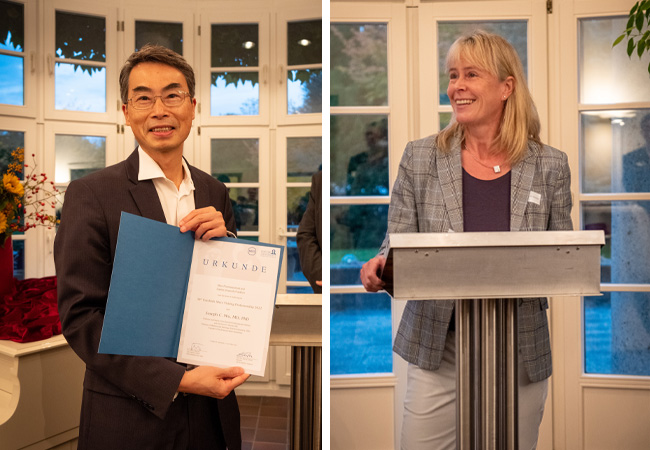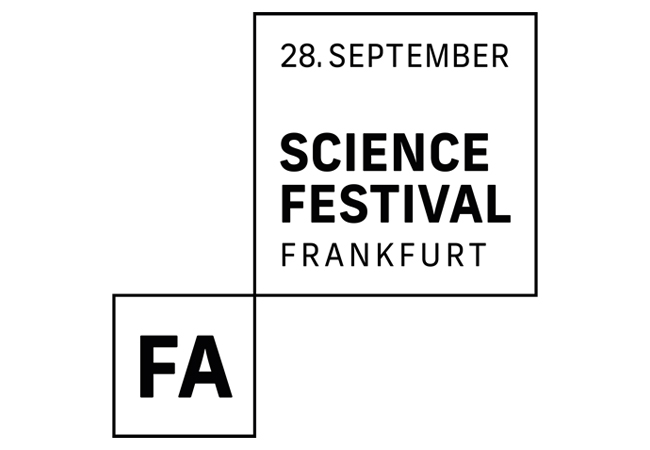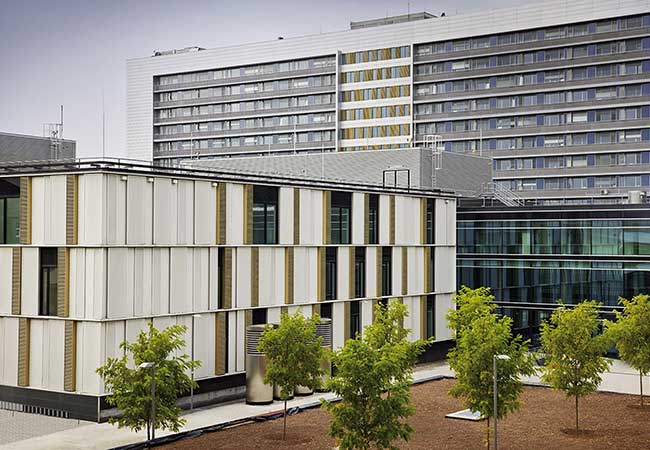A review of the Friedrich Merz Visiting Fellowship Endowment 2022
It is thanks to the research of cardiologists like Joseph C. Wu, professor at Stanford University, that the post-heart attack mortality rate has fallen from 15 percent to just 2-3 percent. At the invitation of the Friedrich Merz Visiting Fellowship Endowment, Wu, who also serves as president of the American Heart Association and is considered to be one of the most prominent contemporary heart researchers, visited Goethe University for a week to exchange ideas with both researchers and students. As part of a public discussion, he also answered questions posed by Frankfurt citizens, in an event that also featured Stefanie Dimmeler, spokeswoman of the German Centre for Cardiovascular Research (Deutsches Zentrum für Herz-Kreislauf-Forschung, DZHK) and head of the Cardio-Pulmonary Institute Cluster of Excellence, among others.

UniReport: Prof. Dimmeler, what are the most important cardiovascular diseases?
Stefanie Dimmeler: These are „cardiomyopathies“, i.e. diseases of the heart muscle, which are often congenital, meaning genetically determined, and are accompanied by mechanical or electrical dysfunctions. In addition, cardiomyopathies can result from an infection of the heart muscle. Among acquired cardiovascular diseases, the most prominent example probably is the myocardial infarction, or heart attack. In this case, the heart is temporarily deprived of blood supply, causing heart muscle tissue to die, which ultimately leads to heart failure (cardiac insufficiency). Damage to the heart can also be caused by valve disease. Finally, age, combined with risk factors such as diabetes, can cause more and more connective tissue to accumulate in the heart, which makes the heart lose elasticity. Although it then is still able to contract, it cannot relax again afterwards and thus absorbs less blood. This in turn means that less blood is pumped out of the heart and that all the body’s organs are less well supplied with blood and can no longer perform their function properly.
How, in principle, can cardiovascular diseases be treated?
Today there exists an extensive range of drugs and interventional catheter-based or surgical procedures. Best-known among the drugs are pharmacological substances such as statins (and other cholesterol-lowering agents), beta-blockers and ACE inhibitors (ACE = angiotensin-converting enzyme). Another new drug is a so-called SGLT2 inhibitor, originally developed and approved for the treatment of diabetes; it was then discovered, almost by chance, that it was also suitable for the treatment of cardiac and renal insufficiency. Apart from this, minimally invasive procedures have also become more commonplace. Use of these can reopen closed vessels, among others. For this purpose, a thin tube is passed through an arm artery to the heart. By implanting stents, i.e. using vascular prosthesis, blockages in the blood vessels are removed. Nowadays it is also possible to replace heart valves with catheter-based procedures – a great option for elderly or pre-stressed patients in particular, for whom heart surgery constitutes a high risk.
Can the heart really be renewed?
Most therapies to date are aimed at reducing damaging influences and diminishing the disease’s further development, including, for example, by preventing cholesterol from further damaging the vessels or by preventing even more connective tissue from being deposited in the heart. Nowadays, true regeneration is only possible by replacing parts of the heart, such as the heart valves, or by transplanting the heart. That is why the goal of current research is to develop strategies on how to develop new heart muscle tissue using healthy heart muscle cells, vessels and intact connective tissue.
How can stem cells contribute to the fight against cardiovascular disease?
Stem cells can be used either for diagnosis or for therapy. One example of diagnosis is the causal investigation of cardiomyopathies: For this purpose, cells from the patient’s blood or skin are first transformed into stem cells (so-called „inducible pluripotent stem cells” (iPS)). In the laboratory, these stem cells are further developed in the Petri dish into endogenous heart tissue. An examination of this artificially produced heart tissue can uncover defects. In the case of genetic causes of cardiomyopathies especially, use of this approach can precisely identify the molecular causes. These new methods are extremely helpful, as heart tissue cannot easily be obtained otherwise: Unlike tumor tissue, for example, which is surgically removed, we cannot simply remove a piece of the heart. The heart tissue developed from stem cells is also used as a tissue substitute – albeit still only in test trials. For this purpose, larger pieces of heart tissue are grown, which can then be sewn onto the heart as a kind of patch, for instance. Ideally, the replacement heart tissue will take over the task of the defective heart regions, allowing the diseased organ to function again.
What are the difficulties or disadvantages associated with stem cell therapy?
Naturally, a „heart patch“ is only ever a makeshift. The difficulty consists of enabling the new tissue to interact with the heart itself so that a synchronized beating of the cardiac muscle cells can occur. Ideally, the integration of the new cells would occur directly within the cardiac tissue, with the environment of the cardiac muscle cells „rejuvenated“ at the same time, allowing a true endogenous regeneration of the cardiac muscle tissue with new vessels and a healthy micro-environment.
What is Goethe University’s research approach to cardiovascular disease therapy?
We use small pieces of RNA that are not translated into proteins, known as micro RNAs, which we try to use to stimulate the repair, and, if possible, even the regeneration of a damaged heart. A special focus of our work is on the so-called aging heart, in which connective tissue, vascular and cardiac muscle cells no longer interact properly. Our goal is to flip the molecular switches that are no longer functioning there. In addition, within our Cardio-Pulmonary Institute Cluster of Excellence we are conducting research on other regenerative methods, together with the University of Giessen and the Max Planck Institute for Heart and Lung Research in Bad Nauheim. As part of this, we are trying to learn from regenerative model organisms such as zebrafish, who are able to regenerate the heart completely, even if a piece of it is cut out. Our goal is to find out how this works so we can perhaps eventually apply these regeneration mechanisms to humans.
How did Goethe University benefit from the Friedrich Merz Visiting Fellowship Endowment’s invitation to have Joseph C. Wu come to Frankfurt for a week?
We had the opportunity to discuss many scientific topics in detail at the Cardio-Pulmonary Institute and to contemplate new developments together. Professor Wu’s work on the use of stem cells in diagnostics and therapy gave us exciting insights. He has also started a first clinical application with heart tissues grown from stem cells on patients. In addition to the scientific discussion, it was particularly impressive and important that Professor Wu spent time with our students, who had little international interaction during the COVID pandemic and clearly enjoyed the opportunity to speak with such a top-notch scientist and physician. Not only did he give them an overview of the last 15-20 years of cardio-vascular research as part of a lecture, he also discussed career prospects and research abroad with them. Not surprisingly, his lectures were well attended, both the scientific seminars as well as the classes for the students. We are very grateful to the Friedrich Merz Foundation for making Joseph Wu’s visit to Goethe University possible.
Questions: Stefanie Hense













